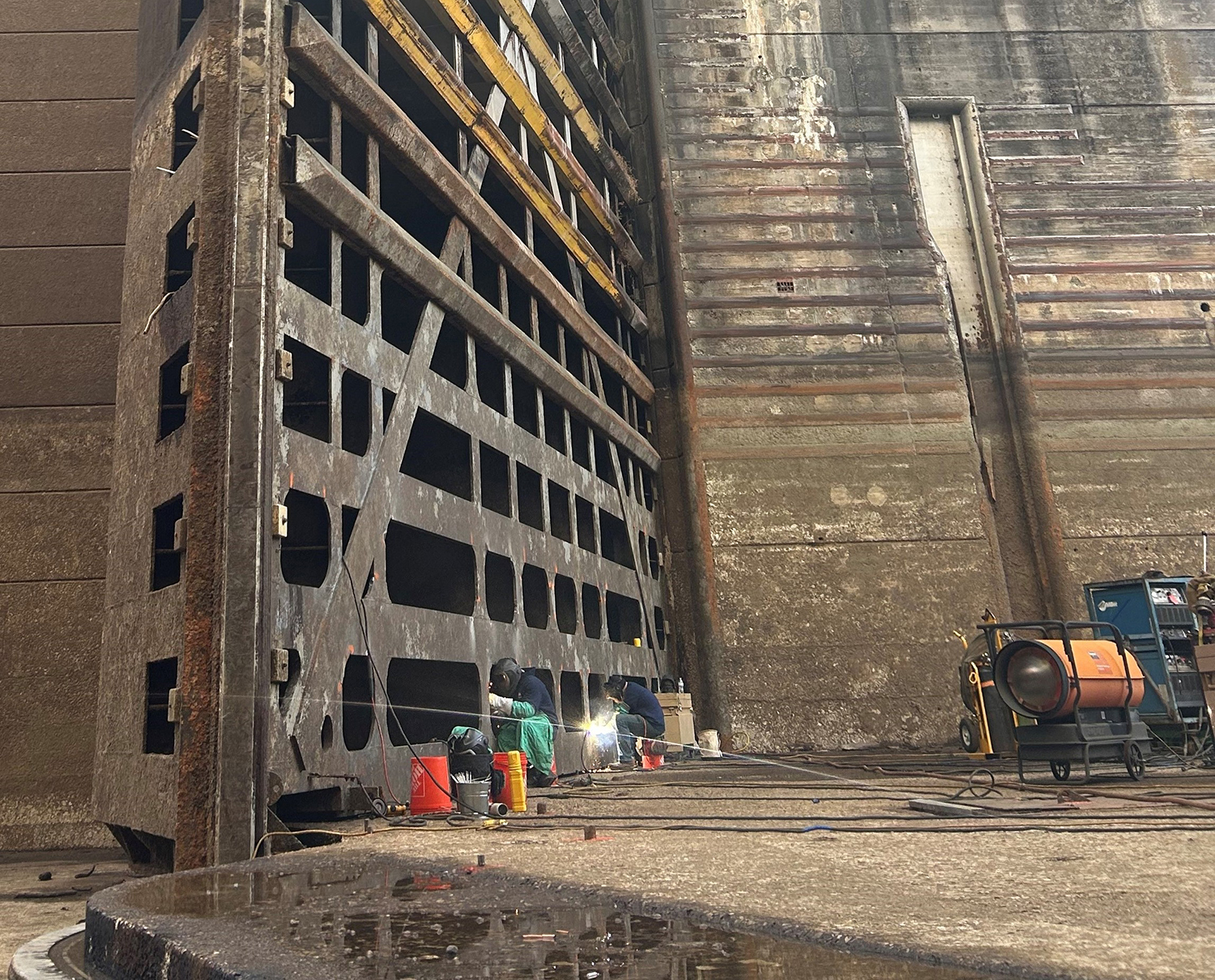Damage discovered when Wilson Lock and Dam’s main chamber was dewatered is too severe to allow navigation traffic to transit the lock between two dewaterings, which means the lock will remain closed for months.
The Nashville Engineer District announced the decision during an industry call December 3 after an inspection and risk assessment by the Corps of Engineers, which operates the lock, and the Tennessee Valley Authority, which owns it.
The lock, located at Tennessee River Mile 259.4 in Florence, Ala., closed September 25 after operators heard popping noises. Divers later found cracks in both downstream miter gates that were not present during a 2022 dewatering.
Some of the cracking is to the gates’ pintle components, which act as the hinge on which they swing open and closed.
An initial repair plan, drafted following a dive inspection, called for welding and potentially bracing cracks as a temporary measure during an initial dewatering, then jacking up gate panels and replacing the pintle castings from late January through late April during a second dewatering. At minimum, the Corps had hoped to pass traffic too large for the auxiliary lock—which consists of 60- by 300-foot chambers in a stair-stepped configuration—between the dewaterings from December 20 to January 20.
“During our dewatering inspection, we identified that the cracking in the pintle cannot be repaired during this initial dewatering,” said Brian Mangrum, chief of the Nashville Engineer District’s technical support branch. “In this case, the cracking in the pintle casting was too significant to risk operation of the gate or of the lock chamber, so we can’t make temporary changes. Placing it back in service would allow continued propagation of those cracks and potential failure of the gate. Also, while we were in our inspection, we looked at several mitigation factors, to include adding bracing of the gate to increase stability, but structurally those measures do not prevent crack propagation in pintles and could potentially place more stress on the pintle assemblies as an unintended consequence.”
The inspection identified damage to gate quoins as a potential root cause of accelerated gate damage, Mangrum said. If the miter gates and lock walls do not fit snugly together when the gates are closed, increased water pressure from the lock filling and emptying can place stresses on portions of the gates not designed to handle it, he said.
“Continuing to operate the gate in the current condition could result in complete failure of the gate or irreparable damage,” Mangrum said.
An initial risk assessment considered the lock’s structural integrity, operational impact and safety risks, although a full assessment is still underway, he said. Mangrum added that he hoped to have more clarity on the scope of repairs and how long they might take in the next week.
Crews from the Great Lakes and Ohio River Division’s Heavy Capacity Fleet were working around the clock repairing typical fatigue cracks, with about 80 percent of general repairs below the waterline completed, Mangrum said.
Instead of waiting until December 20, the fleet planned on leaving the lock chamber within the next few days and staging nearby at Pickwick Lock, which will allow the lock to be rewatered to complete additional analysis and help confirm repair plans.
“We’ve learned a lot this last week, and we’ve got a lot of work to do to adjust our repair plans,” Mangrum said.
He stressed that the Corps is aware of the impact of a prolonged closure causing extended delays locking through the auxiliary chamber. The Corp’s lockage queue system showed the afternoon of December 4 that some vessels at Wilson had been waiting to transit the lock since November 21.
“We’re looking at every opportunity to do things faster and move our repair window to the left,” Mangrum said.
Nikki Berger, TVA’s navigation program supervisor, said there had been about a one-week delay in shipping materials the TVA Power Services Shop plans on using to forge new pintle components in a 12- to 16-week process. Those materials are now expected to be received the week of December 16.
TVA has expedited a study assessing whether a long-term rehabilitation or replacement of the gates is necessary. A contractor was expected on site December 6. The chamber dates to 1959. The dam was completed in 1924, with the auxiliary lock chamber coming online in 1925.
When Tim Parker III, president and CEO of Parker Towing, asked if the Corps believed the quoin and pintle issues to be related, Mangrum answered, “We’ve got really old steel that’s showing a lot of indications of fatigue, so it could be numerous things that are causing different stresses on different portions of the gates.”
The Nashville Engineer District continues to work with the Grat Lakes and Ohio Rivers Division to pursue funding for the repair costs. Mangrum said it appears reprioritized funding will have to come from elsewhere in the region, meaning that scheduled maintenance at other structures may have to be deferred.
That was a concern, he said, as extensive cracking at Wilson had taken place since the 2022 dewatering, and some other aging locks within the district have not been dewatered for inspection for even longer.
He said, “In some cases we haven’t had an opportunity to look at what’s below the water in several years.”
————
Featured photo caption: The Nashville Engineer District has announced that damage discovered in the main chamber of Wilson Lock in Florence, Ala., is too severe to allow navigation traffic to transit the lock between two dewaterings, which means the lock will remain closed for months. (Photo courtesy of Nashville Engineer District)



